New photos are up from our first night of Measure For Measure!
“Some rise by sin, and some by virtue fall.”
The rest of the photos here.
New photos are up from our first night of Measure For Measure!
“Some rise by sin, and some by virtue fall.”
The rest of the photos here.

Boadicea Haranguing The Britons. John Opie, R.A. (1761-1807). Oil On Canvas.
We Three is looking to cast an Ensemble of six performers for our September production of The Passion of Boudicca. We are seeking experienced actor-combatants.
The Passion of Boudicca is a new Elizabethan-style verse play following the military campaign of the legendary queen of the Britons, who sought to expel the Roman Empire from her borders.
PAY: All performers receive a token payment of $50, due no later than September 9 (opening weekend).
If interested, please send your resume to jared@wethreeplays.com.
Although fight experience is required, actors will also be asked to fill small ensemble roles: 1st Briton (two clown scenes and some group scenes), 2nd Briton (two clown scenes and some group scenes), Gaius (group scenes), Mutius (group scenes), and the Roman Knight (one clown scene and some group scenes). All actors will be allowed to read the script before accepting their role.
As actor-combatants, the Ensemble will be principal participants in two-to-four alarum scenes (as our schedule allows). The actors playing Gaius and Mutius will participate in two other fight scenes with lead actors.
All violence will be managed by a professionally-trained violence director and fight-captained by an actor selected from the Ensemble.
Time Commitment: Ensemble will be asked to meet between four and eight times in July, as schedules allow, to focus on alarum fights. Rehearsal time will also be made in August (no more than once or twice a week). The actors playing the 1st Briton, 2nd Briton and Roman Knight will be expected to attend any rehearsals dealing with their respective scenes. The actors playing Gaius, Mutius, and the sixth non-speaking role will be asked to attend relevant scenes at their discretion. There will be at least four full-runs before Tech, featuring the alarums, in the latter half of August.
THE PASSION OF BOUDICCA
CAST
All tickets are FREE!
The Passion of Boudicca will be staged at Chase Park (4701 N Ashland) with the generous cooperation of Fury Theatre.
PERFORMANCE DATES:
September 7, 8, 9, 14, 16, 21, 22, 29, 30
Curtain at 7:30pm
 We Three are exceptionally excited to share that The Wayward Women will be returning to Chicago this September!
We Three are exceptionally excited to share that The Wayward Women will be returning to Chicago this September!
The story of two querulous knights in a post-war culture, The Wayward Women takes place on the Illyria-esque isle of Amosa, where women rule and men are the gentler sex. Cordelius, a foreign noble, and his servant Julian are stranded in this strange land, where they quickly become pawns in the petty machinations of Dame Anu, the Virtuous, and Dame Grendela, the Fartuous.
 The Wayward Women will be running in rep with The Passion of Boudicca at Chase Park (4701 N Ashland Ave), thanks to the generous cooperation of Fury Theatre.
The Wayward Women will be running in rep with The Passion of Boudicca at Chase Park (4701 N Ashland Ave), thanks to the generous cooperation of Fury Theatre.
All tickets are FREE!
PERFORMANCE DATES:
September 10 (5pm)
September 15 (7:30pm)
September 17 (5pm)
September 23 (7:30pm)
September 24 (5pm)
September 28 (7:30pm)
October 1 (5pm)
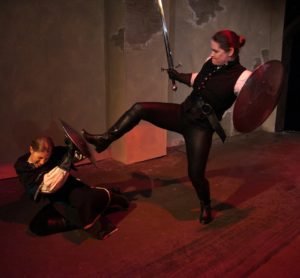
Chelsea Rolfes as a French Soldier and Delia Ford as Exeter. Costumes by Rachel Sypniewski. Lighting by Andrea Trygstad. Photo by Johnny Knight.
Right off the top, I must say: I cannot remember the last time I saw a Shakespeare play where so many actors knew what they were saying and why they were saying it. Shakespeare is done to death because it is free and has a built-in audience, and yet so few theater companies pay any attention to the words they are saying, how sentences are structured, or what these sentences even mean. I find this failing consistently throughout Shakespearean theater, whether it be in high school productions or the highest echelons of local art. This rare exception was a genuine treat.
[tl;dr – Henry V has strong energy, quality production values, and is excellently paced. Diana Coates’ Henry carries the show beautifully with charisma and energy. Though tactics- and characterization-wise she is a a bit of a one-trick pony, there’s no question that she was the actor needed to drive this show. Costuming and staging are traditional, which is very welcome to me. Extra kudos goes to Alison Vodnoy Wolf for her physically, vocally, and energetically diverse portrayal of different characters, and to Samantha Kaufman for her smoothly smarmy Dauphin. Kim Fukawa’s violence stands out for breadth, clarity, and intensity in a city full of violence specialists. This production is well worth your time and money. You can read my other reviews here.]
Of course, Babes with Blades has another vital use for Shakespeare plays besides their economic efficiency: sword fights. Strictly ‘traditional’ gender-casting typically casts women as the victims of violence, regardless of the theatrical era, and this company is founded upon using staged violence to help empower women actors and characters. I mention this because, for a company so dedicated to stage violence to take the time to understand verse (again, something that happens very rarely in my experience and observation), is doubly worthy of admiration. I found no dramaturge or verse coach listed in the show’s program, so I assume this accomplishment rested largely on the shoulders of director Hayley Rice (and the actors, of course), to whom I am immensely grateful. And frankly, even if the rest of the show had been utter garbage (which it decidedly was not), this alone would have made it well worth my time.
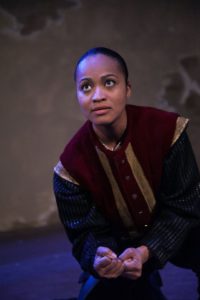
Diana Coates as Henry. Costumes by Rachel Sypniewski. Lighting by Andrea Trygstad. Photo by Johnny Knight.
This particular Henry V is staged in City Lit’s open, expansive semi-thrust space, ideal for presentational acting that seeks to draw an audience in. Whether for budget or effect, the space is wisely uncluttered with redundant bric-a-brac, the walls themselves being the primary environmental art (used to effect by the Chorus at the play’s opening, but more on that later). Small moveables are used throughout both practically and for decoration, and it should come as little surprise that each set piece is simple, beautiful, and internally consistent (thanks to designer Elyse Balogh), while contrasting charmingly but not glaringly with the outer-most set that established the frame tale of this production.
Said frame tale sets us in a rundown classroom of sorts: the walls are dilapidated and peeling, and a transparency projector sits at the far edge of where the stage and audience meets. The Chorus enters at open, examines with overt exasperation the poor quality of the classroom, then speaks the famous Muse of Fire speech, which apologizes that our theater is insufficient for the sweeping and epic drama that is about to unfold. Although I don’t think this framing device adds much to the story per se (though it does allow a brief and knowing smirk regarding the quality of our current education system, to those who wish to interpret it so), it certainly doesn’t overwhelm or detract. Contemporary Shakespeare is so awash in needless concepts and cumbersome add-ons that smaller embellishments are very welcome.
Same goes for the high quality costuming by Rachel Sypniewski. Shakespeare’s war plays are often draped in modern fatigues, presumably to justify a shoestring budget with the illusion of an overdone commentary on the timelessness of war; but if there was ever a Shakespearean war play that justified the pageantry of Elizabethan-esque costuming, it is this largely rose-glassed love letter to one of England’s most beloved unofficial patron saints. Sypniewski’s costumes are well executed and representative throughout: the usual red-versus-blue is established without being obnoxious or overwhelming, rank is clearly indicated by fabric and color (or lack of color), and Hal’s unusually dark costume palette, relatively light on gold, perhaps helps to highlight the rare instances of evil that appear in one of Shakespeare’s most populist plays.
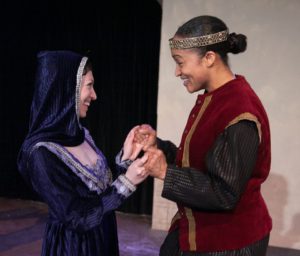
Alison Vodnoy Wolf as Catherine, and Diana Coates as Henry. Costumes by Rachel Sypniewski. Lighting by Andrea Trygstad. Photo by Johnny Knight.
So: the play. Chelsea Rolfes’ Chorus immediately sets a high bar with clear vocal quality and energized delivery, providing strong motivation (and/or clear impulses) for every clause she speaks. This bar proved to be met and occasionally exceeded by virtually all actors. Rolfes’ Chorus, dressed as a school teacher, is aided with the aforesaid transparency projector, presumably to help the audience follow the convoluted and garbled history of British royalty. The concept was unique, but it seemed to me like an apology: either for the script, which we must assume the director loves as she is directing it; or for the actor, whose physical and vocal clarity required no apology; or for the audience, who perhaps were assumed to be too uninformed, uneducated, or un-capable of following the inner mysteries of English heraldry. This last point might have some justification, but audiences (myself included) have been misunderstanding or just plain dismissing the complexities of succession and conquest for centuries, with little adverse effect on the popularity of Henry V.
This conceptualization (which I hasten to repeat, is thankfully far subtler and light-handed than in most Shakespeare plays) finds its heaviest moment in one of my favorite characters, that unsung hero of the comedic canon: the Bishop of Canterbury. Though a bit un-animated for my tastes (and, to be fair, this is a bishop we’re talking about), Jennifer L. Mickelson’s Canterbury is an articulate and natural embodiment of a stuffy authority figure. In one of the greatest examples of too-much-build-up for a punchline that’s only funny because of too-much-build-up, Canterbury presents a famously long-winded, convoluted, and indecipherable speech justifying the invasion of France. Visual aids from the transparency projector highlighted this confusion and scored many laughs, but I can’t help feeling that a skilled actor, un-hobbled by this crutch, could have scored the same laughs on her own. This reached a head at the comedic climax of the speech, where the mere turning off of a projector elicited such a response that it completely drowned out Mickelson’s delivery of the actual punchline. All the same, I should remember that this conceptualization still made the speech very funny, which was the point. This sort of hand-holding so overwhelms most Shakespeare productions, that it seems almost unique and calculated in Babes’ Henry V; though it still seems to betray a lack of confidence in the audience, the actors, or perhaps the script itself.
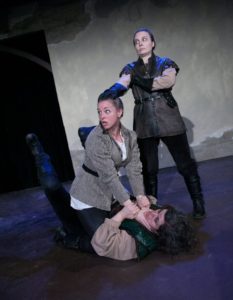
Jennifer L. Mickelson as Gower, Alexis Randolph as Michael Williams, and Morgan Manasa as Fluellen. Violence by Kim Fukawa. Costumes by Rachel Sypniewski. Lighting by Andrea Trygstad. Photo by Johnny Knight.
But enough of my personal literary crusades. This conceptualization quickly fades into the background with Canterbury’s completion, and the show becomes unquestionably Henry’s. In the title role, Diana Coates carries this play as a giant among giants without flagging or failing in her commitment and energy. With a Branaugh-esque veneer of confidence (not necessarily a bad thing), combined with a cleverness and awareness found in more accessible embodiments of Hamlet, Coates powers through this juggernaut of a role with apparent ease and facility, punching or shrugging as necessary and without once even stumbling under the responsibility.
Although her impulses were consistently empowered, Coates’ Henry seemed to be consistently hiding from us. There was so much of the regal, so much of the charismatic and declamatory, that I spent much of my time hoping for the real Hal to eventually emerge from this compelling facade. In this, I was disappointed. Although occasional moments of vulnerability did emerge, they were only to be found in a few silences between lines; that, or occasionally vaulted up to, as though trying to achieve a higher sincerity through force, rather than opening up (or discarding) the princely armor. The snag of it, is that so many of Hal’s scenes can justify this veneer, should we so choose, that it is difficult to fault Coates for so consistently using the same tactics, despite the fact that this sometimes smacks of superficiality.
Of course, it’s easy to criticize an actor when she is so long onstage, carrying so much of the action, and so frequently open to scrutiny. And the consistency of this veneer in a lead character means that director Rice must share at least some of the responsibility for that interpretation. Nevertheless, even in a cast full of energized, articulated, and well-paced performances, there is still no question that Coates was the right choice: she possessed and presented so much of the drive, the charisma, and the power needed to make this show a success, that even now I have trouble imagining many actors who could, not only handle that burden, but succeed with it. It should also be mentioned that the famous staples of “Once more unto the breach” and the St. Crispin’s Day speech held their own subtleties, with the Breach permitting some welcomed moments of uncertainty and Crispin including delightful moments of direct address.

Kim Fukawa as the Constable, and Samantha Kaufman as the Dauphin. Costumes by Rachel Sypniewski. Lighting by Andrea Trygstad. Photo by Johnny Knight.
Although every actor in this production is worthy of praise, special mention goes to Alison Vodnoy Wolf and Samantha Kaufman. Wolf’s diverse characterizations were particularly strong, altering her centering, pacing, and direction of energy to create starkly contrasting characters. Kaufman’s Dauphin was delightfully French and smarmily, smoothly amusing in his confidence, making smart use of the “Frenchness” that underpins this play, without relying on the cliches of emasculation that so frequently color Shakespeare’s Dauphins.
Babes with Blades’ Henry was well-paced, well-produced, and far more importantly in my eyes: it featured informed and articulated performances. I should add in ironic parentheses, that Kim Fukawa’s violence is dynamically compelling both in the grand alarums and in its more intimate moments. Staged violence is what Babes with Blades does, and Hal’s war did not disappoint.
Henry V runs until April 1st at City Lit’s space. It is well worth your $20 and your time. More information can be found here.
Shakespeare!
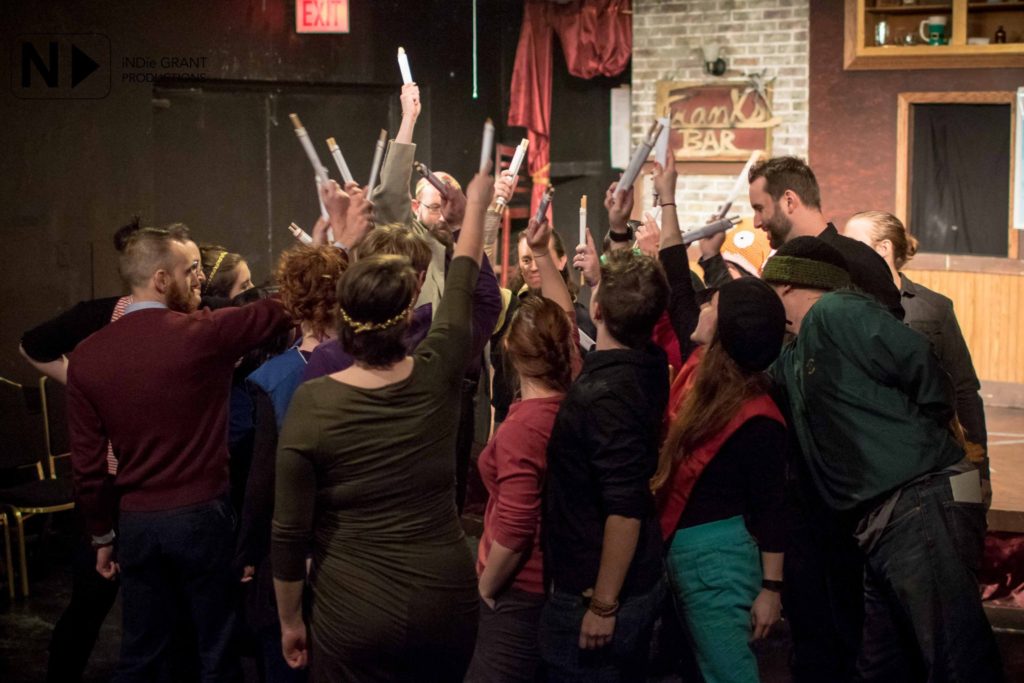
King Lear, December, 2016
Come learn to experience Verse in a dynamic new way (that is actually a dynamic old way). Unrehearsed Shakespeare is a text-based technique inspired by Patrick Tucker’s ‘Secrets of Acting Shakespeare,’ which enables actors to effective and organically stage Elizabethan plays without conventional direction. The technique teaches teamwork, active listening, improvisation, commitment, and above all a strong investment in the text.
All classes take place at Pendulum Theater space, 1803 W Byron Street, #216
COST: $10 per student. Due upon arrival to the first class. Classes are free for all active Unrehearsed performers.
Please contact Jared McDaris or unrehearsedchicago@gmail.c
FEB 26 (Sun) 11am – 2pm: INTRO. Learn by doing. Dive into the basictenets of the technique with your fellow new-comers.
FEB 27 (MON) 7pm – 10pm: STORY-TELLING. A focus on teamwork, listening, and especially following direction for your scene partners.
MAR 5 (SUN) 11am – 2pm: MONOLOGS. A focus on stamina, actor agency and independence, and learning personal feedback and performance evaluation.
MAR 6 (MON) 7pm – 10pm: REUP. Perform full scenes from various plays. Our final night is a recreation of the ReUps that trained performers use as warmups before actual performances.
Photos of our 2017 production of Twelfth Night have arrived. Courtesy of iNDie Grant Productions as usual, these shots are from our closing performance.
Stay tuned for our 2017 season: Measure For Measure, Richard II, and Coriolanus

Here are a few rehearsal photos from Devonshire Playhouse’s production of my Sherlock Holmes: Almost Got Him! You can see more photos here.